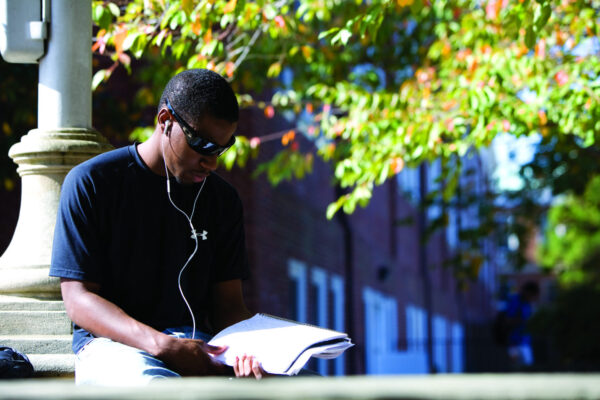By Hollie Chessman and Morgan Taylor
For more on this issue, see our series of posts on College Student Mental Health and Well-Being.
College student mental health—and how campuses are responding—is increasingly in the national spotlight. Headlines in newspapers across the country are reporting that a mental health crisis exists at U.S. colleges and universities, and that it is worsening. Campuses and their counseling centers are seeing increased, unmet demand from students. National assessment data show rising levels of anxiety, depression, and suicidality—suicidal ideation (serious thoughts about taking one’s own life), suicide plans, and suicide attempts—among the college population. In fact, suicide is the second leading cause of death among college students.
As with a host of other complex and urgent issues facing higher education institutions in 2019, institutional leadership on student mental health and well-being matters greatly. To better understand how college and university presidents are navigating this challenge, ACE conducted its third Pulse Point survey at the end of April. Over 400 presidents* responded.
Here’s what we found.
Attention to student mental health has increased
According to national data from the Healthy Minds Study, student mental health concerns have escalated over the last 10 years. We wanted to know how presidents were responding to this increase. To assess short-term changes, we asked presidents to reflect on the last three years on their campus and whether they have observed an increase, decrease, or no change in how they prioritize mental health.
Eight out of 10 presidents indicated that student mental health has become more of a priority on their campus than it was three years ago. As one president wrote, “Mental health has become a major issue for retention and the general well-being of our students . . . This is in my top three areas of improvement for my college.”
Presidents at public four-year institutions (87 percent) were more likely to indicate it had become more of a priority than presidents at other types of colleges and universities.
As concern about student mental health has grown over the last three years, roughly seven out of 10 presidents (72 percent) reported they had reallocated or identified additional funding to address the issue. Presidents at four-year institutions were more likely to have identified or reallocated funding than presidents at public two-year colleges. One president reported raising $15 million to build a “comprehensive student well-being building.”
What presidents are hearing
Concerns related to student mental health are reaching the president’s desk with great frequency. Nearly one in three public and private nonprofit four-year presidents and one in five public two-year presidents reported hearing once a week or more about students struggling with mental health.
Forty-one percent of public and private nonprofit four-year presidents are hearing about these students a few times a month. Close to half (48 percent) of community college presidents are hearing about them with the same frequency.
When asked for the top mental health concerns they hear about, three-quarters of presidents said anxiety (75 percent) and depression (74 percent). While these were the top two mental health concerns across all sectors, presidents at private nonprofit four-year institutions were the most likely hear about students facing anxiety (84 percent) and depression (83 percent).
Presidents at public two- and four-year institutions were more likely to hear about students facing addiction and food insecurity than presidents at private nonprofit four-year institutions. Presidents at private nonprofit four-year institutions were more likely hear about non-suicidal self-injury (18 percent). Presidents at public institutions were more likely to hear about suicide than leaders at private colleges and universities.
Notably, presidents at public two-year colleges were twice as likely to hear about housing insecurity than presidents at other types of institutions.
Who presidents rely on
Presidents count on their senior staff to assist in addressing concerns around student mental health and well-being. An overwhelming 92 percent of presidents reported they rely on their vice president of student affairs or dean of students to help with these issues, followed by their provost or chief academic officer (36 percent), chief of campus police (34 percent), and legal counsel (27 percent).
Presidents at public four-year and two-year institutions (42 and 40 percent, respectively) were more likely to lean on their chief of police than presidents at private nonprofit four-year institutions (28 percent). Notably, presidents at private nonprofit four-year institutions were more likely to rely on their provost or chief academic officer than presidents at public institutions.
Across all institution types, over eight out of 10 presidents (85 percent) identified the vice president of student affairs as their primary point person.
A campus-wide effort
We also asked presidents to reflect on the time staff and faculty have spent addressing student mental health over the last three years. Ninety percent of presidents agreed or strongly agreed that their staff is spending more time addressing these concerns than they did three years ago. Presidents at four-year institutions were more likely than presidents at public two-year institutions to strongly agree that staff is spending more time helping students.
The majority of presidents also agreed or strongly agreed that faculty on their campus were spending more time addressing student mental health concerns than three years ago (82 percent).
Notably, presidents were more likely to strongly agree (60 percent) that staff is spending more time addressing these issues than faculty (32 percent).
“The issues facing students have become more complex and time-consuming for faculty and staff to address,” one president said. “It also involves multiple staff (student services, counseling, security, external resources, safety, legal) to develop a comprehensive plan to address.”
What presidents would do with unlimited resources
We asked presidents if they had unlimited resources to dedicate to student mental health on their campus, what would be the first action they would take? Over half (58 percent) of presidents said they would hire additional staff—mostly in the counseling center.
Over one in five presidents would invest in more enhanced resources or programs. “We are currently working to improve our early alert system for at-risk students to improve retention and persistence,” one president wrote. “As a result of this initiative, students requiring mental health services may be identified and we need to have proper training services in place for their well-being.”
A little over one in 10 presidents mentioned professional development for faculty and staff. “I would broaden the range of people who could help students by [providing] proper training rather than staffing up the counseling center,” one president responded. For example, some institutions are providing Mental Health First Aid training for their entire campus: faculty, staff, and students.
Taking mental health and well-being seriously
Student mental health and well-being is a campus-wide priority at most institutions. Over 80 percent of presidents indicated that student well-being is mentioned in their strategic plan, and over 40 percent of plans mention mental health specifically. Over half of presidents at private nonprofit four-year institutions indicated that student mental health is mentioned specifically in their strategic plan—much higher than presidents who lead public institutions.
Including student mental health as part of strategic plans is an important step; however, many institutions continue to face issues fully meeting student concerns. As one president said, “Our strategic plan and efforts are all about the students, yet we still struggle to meet their mental health needs.”
Students themselves are spending more time focused on their own mental health by starting organizations like Active Minds, a campus-based mental health advocacy organization. These organizations have been empirically shown to effectively shift the campus climate to be more supportive of mental health.
Students also are creatively expanding traditional resources and starting peer support programs. Sixty-five percent of presidents reported seeing their students as very or moderately engaged around the topic of mental health. Presidents at public four-year institutions (32 percent) were the most likely to say their students were very engaged.
To highlight how students are getting engaged around mental health on campus, one president wrote, “Two of our student-athletes started a program to encourage student-athletes and all students to seek help if they are suffering from depression.”
What presidents need
Eighty-two percent of presidents indicated that it was very important for the president to understand issues related to student mental health, and 92 percent said they felt very or moderately knowledgeable about these issues. Presidents at four-year institutions were slightly more likely to report feeling knowledgable about student mental health issues than presidents at public two-year institutions.
Over half of presidents said they need additional tools to help them address college student mental health on campus. Presidents at public two-year institutions were more likely to report not having the tools they needed than presidents at other institutions, while presidents at public four-year institutions were more likely to report they had the necessary tools.
When asked what additional resources would be of value, over one-quarter of presidents said professional development and training for themselves or training directed at specific campus groups like faculty, staff, students, executive leaders, and board members. “We need training to be able to identify someone who may be experiencing a mental health episode or breakdown and strategies to assist that individual,” one president wrote.
Over one-quarter of presidents also reported that concrete tools like assessments or developmental tools to help students build skills around coping and self-care would be valuable for their campus. “We need student assessment tools that signal help is needed,” one president responded. Another wrote, “We need tools to help students develop resiliency and coping strategies.”
As student mental health concerns continue to rise, and as higher education continues to wrestle with the complexity and severity of these issues, campuses remain in a position to support students who may be struggling. This is not a new role for institutions, but as these issues evolve, it becomes more important that assistance for students is available outside of counseling centers. Some institutions are training faculty and staff to identify students who need help and give them the tools to make referrals to appropriate services. The well-being of students—both inside and outside the classroom—should be the concern of all on campus. As one president wrote, “We can’t just solve this by hiring more counselors.”
*Of the 410 college and university presidents who responded to this survey, 78 percent are leaders of four-year institutions (32 percent public, 44 percent private nonprofit, and 2 percent for-profit), and 22 percent lead two-year institutions (21 percent public and 1 percent private).
For calculations that include “All Institutions,” all presidents are included in the analysis. We did not include a separate analysis of private two-year and for-profit four-year institutions due to sample sizes of less than 10 in both cases.
If you have any questions or comments about this blog post, please contact us.




